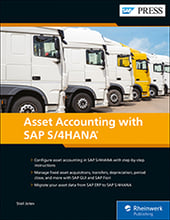Asset accounting is a fundamental subset of accounting processes used to record and report fixed asset transactions.
For example, a fixed asset could be equipment purchased by a company, which they intend to use over a long period of time to generate income. No matter the size of your company, asset accounting is a vital process needed to manage fixed assets.
In the world of SAP, there have been improvements to the financial process area of SAP S/4HANA and, specifically, the asset accounting solution which has been redesigned – and is referred to as new asset accounting.
New Asset Accounting
When SAP redesigned the asset accounting solution, its intent was driven by the concept that all postings to leading and non-leading ledgers should be fully integrated and performed in real time – opposed to the classic asset accounting in SAP ERP which didn’t offer such integration options. With this goal in mind, SAP developed new asset accounting thanks to the extensive capabilities of the SAP HANA database.
Real-time integration with the general ledger brings a whole new level of efficiency and convenience to users, meaning that all asset postings are immediately transferred to the general ledger from all depreciation areas. Since the periodic posting run (Transaction ASKB) from classic asset accounting is outdated, no periodic posting programs are required to complete valuation postings in SAP S/4HANA. In the general ledger in SAP S/4HANA, the ACDOCA table, also called the Universal Journal, integrates all relevant financial data into a single table. All financial and controlling fields, such as fixed assets, cost centers, internal orders, and profit centers, can be found in this table.
For global companies working with multiple valuation principles, the same fixed asset will be treated differently. Asset accounting in SAP S/4HANA reduces the complexity associated with the number of valuation principles global companies have to follow when operating in multiple regions and countries.
When setting up asset accounting in SAP S/4HANA, you’ll always be required to specify your leading valuation principle that is linked with the main book depreciation area, which is integrated with the leading general ledger. For example, more times than not, you’ll find US companies following the US Generally Accepted Accounting Principles (GAAP) – but that doesn’t mean it’s the only set of valuation principles they must abide by. In this case, they can set up multiple depreciation areas to handle the other valuation principles, like the International Financial Reporting Standards (IFRS) for example. On both the country and asset levels, they could then specify which depreciation areas should be active for which assets.
The Asset Accounting with SAP S/4HANA Book
If you’re well-versed in SAP ERP, you’ll be pleased with the new and improved way of handling these multiple valuation requirements with SAP S/4HANA. But like many new and future SAP S/4HANA users, you may need some assistance kicking off your asset accounting journey in SAP S/4HANA. Luckily, our Asset Accounting with SAP S/4HANA book can help you with your transition!
Begin with an introduction to SAP S/4HANA, the SAP HANA database, and SAP Fiori user interface. Before diving into the ins and outs of new asset accounting, you’ll learn how it differs from the classic asset accounting in SAP ERP and how it supports multiple valuation principles and real-time integration with the general ledger.
In the first couple of chapters, you’ll learn how to set up organizational structures of asset accounting (company code, the chart of depreciation, and depreciation areas) and how to configure asset master data including account determinations, screen layout rules, and number ranges.
Next, understand how to value fixed assets according to multiple valuation frameworks. Here, you’ll learn how to set up accounting principles and ledgers, along with how to configure asset accounting’s real-time integration with the general ledger.
An extensive chapter is devoted to teaching you how to configure and use all available business processes in asset accounting. You will also learn how to execute periodic processes like asset depreciation, revaluation, and year-end closing.
The last process you’ll explore is asset data migration, where you’ll learn to migrate legacy data into SAP S/4HANA. From the tools to use, to configuration activities required, you’ll gain insight on the migration process and end with a demonstration on both manual and automated migration processes.
Who Is This Book For?
This book is beneficial for SAP consultants, SAP project managers, finance managers, asset accounting business process owners, and asset accounting users. Users and consultants just starting out on their SAP journey will also find useful information on fundamental business processes in asset accounting.
About the Author
Stoil Jotev is an SAP S/4HANA FI/CO solution architect with more than 20 years of consulting, implementation, training, and project management experience. He is an accomplished digital transformation leader in finance. Stoil has delivered many complex SAP financials projects in the United States and Europe in various business sectors, such as manufacturing, pharmaceuticals, chemicals, medical devices, financial services, fast-moving consumer goods , IT, public sector, automotive parts, commodity trading, and retail.
How to Purchase
If you’re interested in purchasing Asset Accounting with SAP S/4HANA, follow this link and choose the format that works best for you: e-book, print edition, or bundle (both e-book and print).
If you want to continue learning about SAP FICO, or if you want information on other upcoming books or special offers, make sure to sign up for our FICO topic newsletter or our weekly blog recap.
This post was originally published 6/2020.



Comments